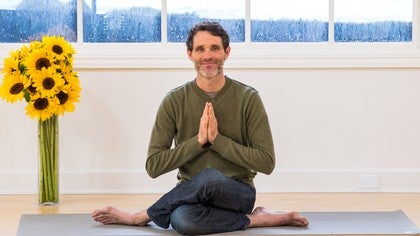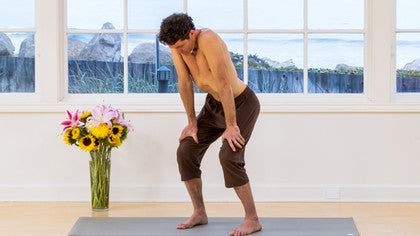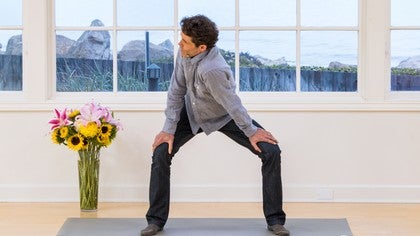Description
About This Video
Transcript
Read Full Transcript
(waves crashing) So, traveling. Everybody wants to know the secret alchemy of traveling and I'm going to give you some tips from yoga (foreign language) for that. And really depending on where you're going, there's lots of things to do to be aware of around you know, the water supply and the kind of ambient bacteria that are in various places, but I want to really just focus in on your immediate experience before you travel, during travel, and then right after you land. And so, let's get to it. So, the first thing is waking up with enough time to actually go through your daily routine in the morning as normally as possible, because doing that really sets you up mentally, emotionally, as well as physiologically to have strong immunity, which is the most important thing when you travel because you're exposed to weird air and weird people and weird things and weird foods, so you have to have your kung fu on to be able to you know, withstand the rigors of transit and so, getting up in enough time to do some yoga is a great idea, and so many of the airports now have yoga rooms, and so if you get there early enough, it's nice to do 15 or 20 minutes of yoga.
Depending on how long your travel is, it might be the last time you get to have a proper place to do yoga for a while, so I highly recommend that you spend at least a half hour doing yoga, as well as going through cleansing the five senses, which we practiced in another session, so you can look that up, if you don't already know what those are, but there's a wonderful sequence of cleaning the senses in (foreign language), and so those two things together are very, very useful for setting things up. The other thing before you travel is, it's often the last time you're gonna get to eat food that you cooked, because I, you know, think that taking soup and eating soup and you know, easy to digest foods is really important, but sometimes you're at an airport and it just doesn't, you don't have great options. So, also, wake up, prepare yourself early enough, so that you have a really good meal before you even set out from your house. So, that's also, and that ranges, but my personal opinion is that soup is the easiest food to digest, so having something where you make a soup for yourself that's hearty and nourishing and really warming to your belly is great. The other thing that is of utmost importance is to have some kind of immune protectant herbal regime, and some of the most basic things that are very, very good for warding off colds and flus are things like cinnamon and mint and ginger and turic.
There's an easy to get leaf called lemon balm, it also happens to be really delicious, that's a great anti viral herb, and you can literally make a tea with all of those things together. It's useful to put lemon into those kind of teas because the lemon is great for your digestive system and your immunatory system. If you're somebody who is more vada, then I highly recommend you doing something along the lines of those roots like ginger, a little bit of turic, you might add a little bit of honey or maple syrup and some lemon to it, so you get the flavors that are balancing the vada. If you have more kuffa, then a bigger dose of turic or ginger are a wonderful complement for that kind of constitution. And then if you're more of a pitta type of person, having the lemon balm with mint is really great, too.
But you know what I do? I put 'em all together, because it becomes a natural herbal formula for really promoting strong immunity. The Chinese system of herbal medicine has an herb called a straglos, it's called wong chi in the Chinese system, but it's a straglos and a straglos is also, it's an adaptogenic herb that's really, really wonderful for promoting the immune system, because it actually has a strong anti viral quality, and usually when you're traveling, that's what's gonna be what you're gonna be exposed to in airports and planes, trains, and automobiles is viruses you're unaccustomed to, so I'm a big fan of building some kind of anti viral herbal medication system that you're taking. And the last thing to consider is to make sure that you have a B complex. You're either eating foods that are gonna supply that, and things like nutritional yeast will do that.
There's a lot of wonderful food based multi vitamins now where you can be sure you're getting your B vitamins because those are also really essential for keeping your nervous system grounded and integrated through a process that's, you know, challenging for anybody in the best of conditions. So, let's move on to what you do while you're traveling. So now that you're in your journey and you're on whatever you're in transit in whatever mode you're gonna be in transit in, let's look at the things that, you know, little things that can really make a big difference. So, from both Chinese and (foreign language) perspective, the neck area is very important to protect, as well as the senses, so I have this kind of setup where I almost always wear a scarf, even if I'm wearing a T-shirt, I'll bring a scarf because it's just nice to keep the neck warm, it also can double as a pillow and you can do lots of things to make things more cozy while you're, you know, having to sit still for traveling. I also always bring an eye mask, and I also always bring ear plugs because as soon I cover the eyes, as soon as I plug the ears, I'm sort of in a kind of safe harbor of quietude and darkness and there's lots of things that you can do like meditation practices and breathing practices in that space, which we'll get into in a second, but it is to say that by kind of drawing your senses inward, it helps to conserve your energy, it helps to concentrate your energy, which will also make you stronger.
Another thing when you're in the process of travel is hydration. For one reason or another, we become hydrated while we travel, but it's especially true in air travel, because of the way the air is compressed inside of the cabin, et cetera, and so drinking water is really great, but also is using things that are more Gatorade, like coconut water or lemon water, because it actually is that sour sweet kind of taste that goes into the liquid actually helps the fluids to penetrate and be retained by the body more effectively. Along with that is, it's actually important what you expose your mind to while you're traveling, as well, and so from a yogic perspective, things like mantra practice, things like breathing practices, meditation practices of all kinds, are a kind of mental floss where you are clearing the minefield of sort of disruptive factors in all their forms and centering and grounding and so whatever you're drawn to or already have a practice with, highly recommend that, and so what I've noticed is when I've done travels to Asia or these very long trips from the United States, very long flights, it can make a tremendous difference in the sense of how time passes. If I stay very meditative, very concentrated mentally, I'll often arrive in the place and I won't feel that worn out, even though I've been traveling for many, many hours, and so the movie watching, book reading, all those things are fine, they're great, in fact, because it's nice, you know, we're natural story tellers as humans, so it's very positive and important, I think, to be able to immerse your mind in stories while you're traveling, but just be selective, because if it's you know, all five of the Transformers movies and you've had things exploding for you know, eight hours, that's gonna affect you, so it's good to, it's good to be discerning about what you pick to work with, and I personally always find that I'm like, I don't know why, but I always get into kind of deep existential states on planes and in airports, so it's much easier for me to cry on a plane, so I'll actually intentionally look for kind of deep movies that will move my heart and I'll allow the tears to flow because it's really therapeutic to be able to sit there and sort of have a catharsis. And so, those hopefully give you a little bit of an idea of what you can do with your conscious awareness, and then lastly, while you're sitting in the chair during travel, lots of people sleep on planes, trains, and automobiles, if you're more vata or pitta, often those types don't sleep as easily, but pitta, kuffa, those types will often be able to sleep, so it just depends on who you are, but if you need a little bit of assistance kind of getting into a deeply relaxed state, I highly recommend that you think about some relaxing herbs like velarion or skullcap, chamomile, you can also use tryptophan rich foods like bananas or actually some of the supplements that exist like 5HTP which is a tryptophan precursor, and tryptophan is famous as the thing in turkey that causes everybody to get sleepy after they eat it, and so basically, tryptophan rich foods will naturally make you more capable of relaxing and even sleeping.
And so that's very useful. Now, one of the major challenges of travel while you're in transit is that your lymphatic system needs to move to keep your bodily systems really regulated, and it's primarily, actually, moved by physical action. So, you know, they have those wonderful movies, or sometimes it's drawn out of different exercises, like pointing your toes, you know, turning your ankles, pointing your toes while you're sitting in the seat, that kind of thing is wonderful. Another thing you can do is go between kind of slouched position because for some reason I think they built those airplane chairs for slouchy people, or you sitting up and feeling you know your posture and kind of holding yourself in a more natural position where you're actually holding your own body weight with your spine, those little shifts are very useful also to keep you feeling like you're, you know, not stagnating too much while you're in the seat that you're sitting in. There's little things, too, where you can just make little circles with the nose and the head, circles with the shoulders, with the wrists, without having to really sort of try to stretch out in your space.
All those little wiggly things actually add up to helping you be a lot more balanced as you travel and actually helping your digestive system to work better because your whole GI track is lined with lymph and so even something as simple as like a minor cat cow while you're sitting in the chair on the plane can go a long way to actually really promoting healthy digestion elimination. But there you are, maybe you're on a long flight and you're starting to feel stiff, or you know, you need to walk, it's really useful to walk about once an hour on a plane, it's a lot of getting up, I usually, on very long flights, get an aisle seat for that reason, because I'll be able to get up without disturbing somebody. And so, I want to show you one of my favorite things to do and I usually end up sifting back where the bathrooms are or the galley of the back of planes, especially on these really long transcontinental kind of flights, and I'll show you a couple things that I do. OK, so, you're sitting there in the chair, you can do a little bit of back bending, you can do a little bit of forward bending in the chair, but the twist factor, as well as kind of stretching the hips, it's hard to get in the chair when you're seated on a plane or a train or something like that, so this is one of those ones where actually this movement is really great for opening the outer hips and really helping the back to be more relaxed, and so very simply what I want you to do is you're gonna take your right foot in front and you'll bring your left foot behind you and you'll bring your arms out like this. And then as you exhale, you're gonna bend your knees and try to just sit straight down.
Your spine is more or less straight. And you're gonna stack your left elbow on top of your right when your right knee's on top. Then you come back up and stretch your arms out, you step, you bring the other foot behind, and what's nice to do, this is actually you're intentionally kind of pumping in and out of this. We'll do it five times. So, you exhale down, and inhale up, and again, the big challenge is you're having to sit still so much when you're traveling.
And so doing this kind of an action where you pump in and out of this shape, can be really, really helpful for getting basically, it's a whole body circulation stimulation you get from this one. One of the things to be aware of is this is for your hips and if you lean forward too much, it'll go into your back, so try and keep your spine upright, you just let the hips take you down into it. And if you have the flexibility, you can go all the way down. Again, we're gonna pump in and out of this five times. This is kind of like an outer hip stretch, but it's a stance, so it's strengthening, tones the legs, where's the circulation in the legs?
And you just want to stay relaxed in your shoulders, keep a nice rhythm as you go in and out of the shape. So we do one more, and you know, before you try to get too macho on your plane ride, even if you go a little bit down, that's great, it does a lot of the same things to the shoulders and the hips than going way deep into it, whereas if you crash in the gates and try to force yourself down into that deep variation of it, you might find that your knees complain or your neck or your back complains, "Please don't do that," because they're nice and we want to be nice to them. So then, after you do that like five times, then it's nice to kind of get into it for a few breaths. We'll take about five breaths, find a spot where you can maintain it for that length of time. Nice, long inhales.
This really charges the legs, so it feels great when you've been sitting there to have your legs work a little bit. One more breath. Knee up. And then we're going to go into the other side. Again, arrive at a nice alignment, do the eagle arms with the hands, if you can't quite get the hands to touch, you can just cross the elbows like that.
Just a few more breaths. Good, then come up. And when you come up out of it, it's nice to do then, is you can widen your feet, move forward like this. You can go out as you bend your knees, you can drop one knee down and look down. And then one shoulder down and look down, and then up.
And just gently twist your upper spine. And your neck. Sort of like inhale the center, exhale then twist. And again, all these things are like things you can do inside of a phone booth, you know, it's like, they're not taking up that much space because you often don't have it to take up. So these are all, you know, I started doing sort of intuitively on planes.
And then, you finish, straighten the legs and just fold over and just let the neck and head traction. Of course, if you prefer to have your feet closer together, you can do that. With this kind of position, really focus on having your feet grounded, focus on relaxing your neck. So, if you love a big stretch sensation, you know, go for it, but it's really, really useful to let your neck traction via the weight of your head and the shape. So, let's take one more breath in this forward bend.
And then lower yourself up to stand, one vertebrae at a time. You can finish the sticking your hands onto your hips and stretching your chest open. And then come back to neutral. Feel your feet ground. Regulate your breath, just relax.
I was on a flight not too long ago and the Air France stewardesses were all taking their break in the galley and I was doing my thing, and at first they were sort of wondering who this weirdo was, and then, you know, five minutes into it, they all gave me the big thumbs up, because they could see what, they probably wanted to be doing what I was doing, which is I was just taking care of loosening everything up, and they thought it was pretty, they liked this move. I remember they all perked up when I did this move. They thought that was pretty cool. Kind of sky ninja esque. Great, so let's sit back down and then we'll talk a little bit about some good ideas for when you land.
So now you've landed. And you may be in a time zone that's very, very different from the time zone you started in. From the (foreign language) perspective, our bodies take one day to adapt to every time zone we move through. So, you know, if you go to the other side of the world, theoretically, you're not going to adapt for quite a while, but that doesn't mean you should be discouraged. It's just more to say that it's good to recognize that you're going to be acclimating and adapting continually for a while, so here are a few ideas about things that are very, very useful to do when you land, kind of in that first 24 hours.
One thing is to adopt the time of the place you're going to, so if you've flown from evening wherever you started, and you land in the morning, it's a very good idea to drink a cup of tea or a cup of coffee on the plane right before you land to give your body a little stimulation so that you enter the waking, woken up state. And then when you get off the plane, take a walk, get some sun, if you're in a nice warm place, actually maybe do a little bit of sunbathing, because it's sort of a well known factoid that your sun exposure is very good for reducing jetlag. It also your body gets queued on which time zone you're actually in. And then, so there can be a real strong pull towards taking a big nap or something like that when you arrive. If you can, in the morning, persist.
Plan yourself a busy day, get out, get stimulated, do stuff, and sleep in the evening, because you'll adapt so much faster to the time zone if you do it that way, whereas if you sleep in the middle of the day, you may end up taking a three or four hour nap, and it can actually take you days to catch up to the time zone if you begin your trip that way. Secondly, eat food that's very easy to digest. Don't try to get too fancy or complicated about what you consume, so it's back to having soup, it's back to having really easy to digest vegetarian food. And you know, something like a little bit of beer or wine or something like that is not necessarily a bad idea, either, because it helps you to relax and ground. It also, they're digestive, so if you're having a small amount, it can actually help your digestive system, as well.
The process of getting going in the place is highly recommended you actually walk a lot the first day. Pick out something where you can tour around and get a lot of steps in because walking is really excellent for your elimination and you know, getting back into steady elimination is the foundation of having good digestion in a new place, and so go and walk around. The other thing that you can do is to do a yoga practice where you favor poses like, you know, (foreign language), something like this, which will stretch your hips out. And fold forward in this kind of a thing. You might even try that right now, just cross one leg over the other.
Put the right leg on top. Take a breath and exhale and lean forward, take two or three breaths here. As you sit in it. And just let your hips relax, massage your lower abdomen with your breath. This one naturally lends itself to a twist, as well.
You can sit up and twist in this shape. And then you can switch sides. First get yourself grounded and then lean forward. I'm a big fan of looking at these things as an opportunity to breathe into your lower body, so stretching is fine, but if your breath sensation penetrates into your belly, your pelvis, that's even better, that's a sure sign that you're gonna be promoting all the circulations for your internal organs. Then you can twist.
I'm a big, big fan of this kind of thing after a long walk and then what you can do, after you do some twisting and seated work is some restorative yoga, but do it consciously, so that you, it's that whole thing of like, you're actually relaxing, but you're not going to sleep, because you're going to wait until you're at a normal bedtime in whatever place that you're at, before you go into that. One of the best (foreign language) herbs for helping you to acclimate to a new climate is (foreign language), which is very easy to find nowadays. It's the root of the winter cherry, and so it is a very mild tasting herb, it goes great with licorice, and licorice ginger, because they help you to, those are both excellent for the adrenal glands, for digestion, and so a normal sized dose would be sort of 500 milligrams, like one capsule, and you know, combining that with something like triphola power, a capsule, each of those, is an excellent way to promote less jet lag, good elimination, good digestion, strong immunity when you arrive in a place, and finally, taking a sauna. It's really, really useful if you can get to a sauna the first day that you arrive at a place, because sitting in a sauna will help to actually reduce the imbalance goshas that can come from traveling very quickly and very effectively. And you know, if you go to Bali or someplace that's steamy, you're already in a sauna, so it has that effect, and then you just conduct yourself, you know, and really appreciate the warm, moist air and weather, and you know, the sweat that comes from it, because it actually will help your body to purge anything that you picked up along the way.
Namaste.
Prana: Robert Svoboda & Scott Blossom
Comments

You need to be a subscriber to post a comment.
Please Log In or Create an Account to start your free trial.







